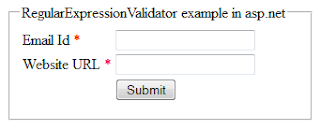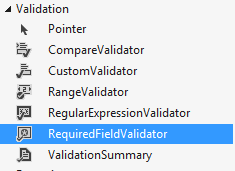Introduction: While creating user input form e.g. registration form where user enters the details like Name, email address, password and confirm password ,Website URL etc. we have to implement validations on the form so that incorrect data could not be submitted to server. Asp.net provides Validation controls like CompareValidator, CustomValidator, RangeValidator, RegularExpressionValidator, RequiredFieldValidator etc to apply validations on asp.net web page.
 In previous article i explained How to use RequiredFieldValidator validation control and CompareValidator andRangeValidator and CustomValidator. and JavaScript validation in asp.net website and Jquery form validations in asp.net.
In previous article i explained How to use RequiredFieldValidator validation control and CompareValidator andRangeValidator and CustomValidator. and JavaScript validation in asp.net website and Jquery form validations in asp.net.
Now in this article I will explain how to use RegularExpressionValidatorcontrol with example to check the validity of the email address and website URL before submitting to server for processing otherwise error message will be displayed to the user.
Note: Email Id should be in email format e.g. me@mydomein.com and Website URL should be like http://www.webcodeexpert.com/.

 In previous article i explained How to use RequiredFieldValidator validation control and CompareValidator andRangeValidator and CustomValidator. and JavaScript validation in asp.net website and Jquery form validations in asp.net.
In previous article i explained How to use RequiredFieldValidator validation control and CompareValidator andRangeValidator and CustomValidator. and JavaScript validation in asp.net website and Jquery form validations in asp.net.Now in this article I will explain how to use RegularExpressionValidatorcontrol with example to check the validity of the email address and website URL before submitting to server for processing otherwise error message will be displayed to the user.
Note: Email Id should be in email format e.g. me@mydomein.com and Website URL should be like http://www.webcodeexpert.com/.
In this example I have demonstrated 3 ways to use RegularExpressionValidator control.
Case 1: If you want to show the validation failure message near to text box for which the validation failed as shown in figure below:
then In the design page(.aspx) Place two TextBox controls for entering Email Address and Website name i.e. URL and a Button control for Submitting . Also place a RegularExpressionValidator validation controls from validation category from the visual studio toolbox as shown in below:

<fieldset style="width:450px;">
<legend>RegularExpressionValidator example in asp.net</legend>
<table>
<tr>
<td>Email Id <span style="color:red;">*</span></td>
<td>
<asp:TextBox ID="txtEmailId" runat="server"></asp:TextBox>
<asp:RegularExpressionValidator ID="rgeEmailId" runat="server"ErrorMessage="Not a valid email format" ForeColor="#FF3300" SetFocusOnError="True"ControlToValidate="txtEmailId" ValidationExpression="\w+([-+.']\w+)*@\w+([-.]\w+)*\.\w+([-.]\w+)*"></asp:RegularExpressionValidator>
</td>
<td> </td>
</tr>
<tr>
<td>Website URL <span style="color:red;">*</span></td>
<td>
<asp:TextBox ID="txtWebUrl" runat="server"></asp:TextBox>
<asp:RegularExpressionValidator ID="rgeWebUrl" runat="server"ErrorMessage="Not a valid web site url format" ControlToValidate="txtWebUrl"ForeColor="#FF3300" SetFocusOnError="True" ValidationExpression="http(s)?://([\w-]+\.)+[\w-]+(/[\w- ./?%&=]*)?"></asp:RegularExpressionValidator>
</td>
<td> </td>
</tr>
<tr>
<td> </td>
<td>
<asp:Button ID="btnSubmit" runat="server" Text="Submit" />
</td>
<td> </td>
</tr>
</table>
</fieldset>
Case 2: If you want the validation failure message to show in pop up as shown in figure below:
then change the Display property of the RegularExpressionValidator validation controls toNone and place a ValidationSummary control from the same validation category from the visual studio toolbox. Set the ShowMessageBox property to true and ShowSummary tofalse as shown below :
<fieldset style="width:300px;">
<legend>RegularExpressionValidator example in asp.net</legend>
<table>
<tr>
<td>Email Id <span style="color:red;">*</span></td>
<td>
<asp:TextBox ID="txtEmailId" runat="server"></asp:TextBox>
<asp:RegularExpressionValidator ID="rgeEmailId" runat="server"ErrorMessage="Not a valid email format" ForeColor="#FF3300" SetFocusOnError="True"ControlToValidate="txtEmailId" ValidationExpression="\w+([-+.']\w+)*@\w+([-.]\w+)*\.\w+([-.]\w+)*" Display="None"></asp:RegularExpressionValidator>
</td>
<td> </td>
</tr>
<tr>
<td>Website URL <span style="color:red;">*</span></td>
<td>
<asp:TextBox ID="txtWebUrl" runat="server"></asp:TextBox>
<asp:RegularExpressionValidator ID="rgeWebUrl" runat="server"ErrorMessage="Not a valid web site url format" ControlToValidate="txtWebUrl"ForeColor="#FF3300" SetFocusOnError="True" ValidationExpression="http(s)?://([\w-]+\.)+[\w-]+(/[\w- ./?%&=]*)?" Display="None"></asp:RegularExpressionValidator>
</td>
<td> </td>
</tr>
<tr>
<td> </td>
<td>
<asp:Button ID="btnSubmit" runat="server" Text="Submit" />
</td>
<td> </td>
</tr>
<tr>
<td colspan="3">
<asp:ValidationSummary ID="ValidationSummary1" runat="server"ForeColor="#FF3300" ShowMessageBox="True" ShowSummary="False"HeaderText="Please correct the following:" />
</td>
</tr>
</table>
</fieldset>
Case 3: If you want to show validation failure message in a separate place as shown in figure below :
then Set the ShowMessageBox property to false and ShowSummary property to true as shown below.
<asp:ValidationSummary ID="ValidationSummary1" runat="server" ForeColor="#FF3300"HeaderText="Please correct the following:" ShowMessageBox="false" ShowSummary="true"/>


No comments:
Post a Comment